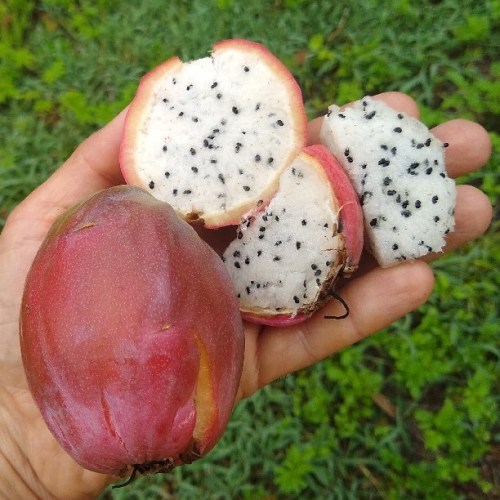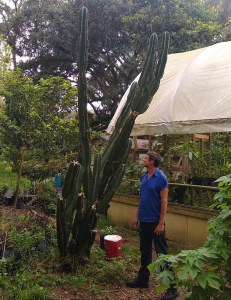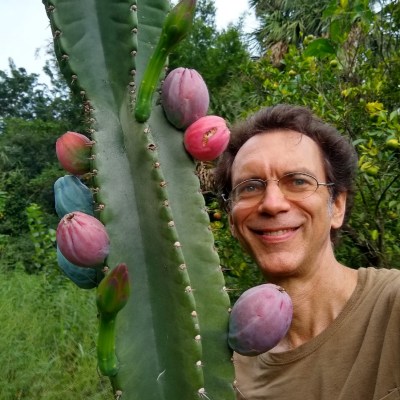
I’ve started growing kadushi (aka Peruvian apple cactus), and I’m getting increasingly excited about its potential for fruit production. While another group of fruiting cactus species, dragon fruit (Hylocereus & Stenocereus spp.) has exploded in popularity in recent years, kadushi has been largely overlooked as fruit producer, despite possibly having at least as much potential, and maybe even some advantages over dragon fruit.
Kadushi, Cereus repandus (aka Cereus peruvianus), is a tall, columnar, multi-stemmed cactus native to South America. Its fruit is up to 4 inches (10 cm), with a red leathery inedible skin, and a white flesh speckled with black seeds. The fruits I’ve eaten have a complex aroma reminding me of candy and flowers. The flesh has a texture like watermelon flesh, with flavors resembling sweetened shaved ice and kiwifruit, along with floral notes. The small seeds provide a pleasant crunch. Reportedly fruit quality varies considerably from clone to clone, with some cultivars having bland fruits, and others with sweet flavorful ones. I’ve heard that the flesh is especially good as a dehydrated fruit.

A note on the common name. In Florida, among English speakers Cereus repandus is often called Peruvian apple cactus. This name is kind of awkwardly long, as well as misleading – the fruit is nothing at all like an apple. I looked for any other common names, and found that in parts of the Caribbean and South America, the common name is kadushi (also spelled cadushi), from the word for the plant in the Wayyuu Arawak language of Venezuela, where this species is from. I’m choosing to use this name because among the various common names for this species, “kadushi” has the advantage of historical precedence, it’s less awkward (shorter), it does not contain a misleading reference to another fruit, and it’s already in widespread use in the region where the fruit is from. Plus, it’s just fun to say kadushi.
I started growing Cereus repandus with I got a cutting from Oliver Moore’s plant in Gainesville, which he got originally from Don Knight in Tampa. I stuck the 3 foot cutting stuck in the ground in 2018. A year later the plant had grown to five feet tall, and it ripened a few fruits. Currently in late 2020 it’s about nine feet tall, and has set several crops of fruit this year.
I was sufficiently impressed by that first plant that the following year in 2019 I got cuttings of several other clones of this species from Josh Jamison, including the named variety ‘Leila Ave’, collected originally by the late John Starnes and reported to be of particularly good flavor. Those plants have grown larger over the last year, and several of them have ripened a few fruits in 2020 (Unfortunately ‘Leila Ave’ has not yet fruited for me). I also have a batch of seed-grown plants, described below.
My plantings of kadushi are all very young, and at the time of this writing I’ve only eaten a limited number of fruits, from several different cultivars. But I’ve generally been impressed with the fruit quality. They tasted at least as good as many of the dragon fruits I’ve eaten, maybe even a little better. So far I haven’t noticed much difference in flavor from one clone to another – they’ve all been pretty good. As I get more varieties into prime fruiting age, I’ll have more opportunity to compare fruit quality of the various clones.
While many types of cactus from arid areas tend to be prone to disease when grown in Florida’s humid, rainy climate, all the plants I’ve seen of kadushi cactus around here have appeared to be growing beautifully, with little sign of any sign of disease.

The flowers of Cereus repandus are big, white, round blooms. The flowers are nocturnal, with each blossom opening for just a single night. The flower opens a few hours after sunset, and closes shortly after dawn. In my experience, the time from flower to ripe fruit seems to be about sixty to ninety days. Flowering and fruiting tends to occur in flushes, with a group of flower buds forming at the same time, all of which flower within a few nights of each other, resulting in a crop of fruits which two to three months later which all ripen at the same time. One plant can have multiple flushes of flowers and fruit simultaneously, with each group at a different stage of development.
I’ve seen reports that many forms of Cereus repandus are self-incompatible, requiring pollen from a another clone in order to set fruit. At least one cultivar in my collection (the one originally from Don Knight) has turned out to be self pollinating – it has set fruit from blossoms that occurred on nights when it was the only Cereus clone here flowering.

Kadushi plants seem to require full sun in order to produce flowers and fruit. Oliver Moore reports that his large plant, probably about a decade old and growing well despite getting only a few hours of sun a day, has never flowered or fruited. The cutting I took from that plant and planted out in full sun made flowers and fruits after just a year in the ground.
Based on the fruits that I’ve eaten from them, I’d say the clones I have of Cereus repandus have fruits good enough in size and flavor to be sold commercially. The overall experience of eating them is roughly similar to eating dragon fruit, which is already a major commercial crop, and I think the taste of these is at least as good as, and maybe even better than many of the dragon fruits I’ve eaten.
One potential drawback is that the fruits have a tendency to split open on the plant. That’s okay in a home garden fruiting plant, but not acceptable for a commercial fruit crop. So far, I’ve used fruit splitting as an indication that a fruit has ripened as much as it possibly can on the plant, to ensure maximal flavor. I’ll be checking to see if the fruits reach peak flavor at a stage before the skin has split. I’ll also be observing to see if some cultivars are less prone to fruit splitting than others.

The only reference I can find online to anyone making a systematic attempt to breed Cereus repandus as a commercial fruit is a breeding program in Israel which reported selecting this species for for taste and resistance to fruit splitting. The breeders gave the commercial name “Koubo” to the plants resulting from this program, and farmers grow and sell the fruit under this name in Israel.
I ordered seed from an Ebay vendor in Israel, who said that the seeds are from the commercial Koubo fruits. The seedlings have grown rapidly. I planted the seed in two batches, in late 2019 and early 2020, and the seedling plants are mostly 4-5 inches tall at the time of this writing in late September 2020. I expect them to be ready to plant out in the ground in spring 2021.
Reportedly this species is hardy to the low 20s F (-5C). Some winters in my area have gotten colder than that. I have seen plants it it around Gainesville which appear to have been there for a number of years, so apparently at least some clones can take the colder winters the area experiences (unless someone was covering those plants during hard freezes). I’ll be ready to protect at least the base of my plants if any extreme cold should threaten.
I am on the lookout for varieties of this species with especially flavorful fruit. If you know of any such plants, please get in touch. I’m also interested if there are forms of Cereus repandus or related species with pigmentation to the flesh of the fruit like some of the forms of dragonfruit – that would be an appealing characteristic to breed into commercial cultivars.

Comparing Peruvian apple cactus to dragon fruit, Cereus repandus is more cold tolerant, enabling cultivation in frost-prone areas. It is also free-standing, without requiring the construction and maintenance of any sort of trellis like dragon fruit requires. And at least some forms of Cereus repandus taste better than at least some forms of dragon fruit, although there are bland forms of Cereus repandus, and some forms of dragon fruit might be tastier than even the more flavorful types of Cereus. One advantage many types of dragon fruit definitely has is visual appeal – some dragon fruit breeds have intensely pink or purple flesh. Kadushi fruit flesh closely resembles the white fleshed forms of dragon fruit. Also, as I mentioned, one drawback for cultivating Cereus repandus as a crop is that many of its fruits split open on the plant.
Overall, Cereus repandus seems a promising species as a home garden fruit, and maybe a commercial fruit crop, for areas prone to frost, maybe USDA zone 9. Considering how little attention has gone into selecting good fruiting varieties, it seems to have enormous potential for development as a fruit crop. While dragonfruit in recent years has become widely cultivated and a darling of social media, its cousin kadushi has languished in relative obscurity while “hidden in plain sight”, often grown as an ornamental in warm climate areas of the world. I think it deserves more attention as a fruiting species.
Very nice tutorial, Oliver!
I’m about to start a banana grove experiment in Yoakum, Tx. Climate zone 9a. That’s the novel project for this winter, along with all of the things still underway. Over half of the avocado trees I put in, almost a year ago have thrived. Drip watering from 2:30 PM to 4:30 PM daily has really minimized the sunburn on the green bark, Still, the low, bushy ones did much better, so I will shorten the tall ones in December or January. Everything that got hurt last winter, one way or another, and came back short, did better. (I have not been able to get ahold of Bill Schneider in Devine in 2020.)
LikeLiked by 1 person
Thanks for the update, John. Good to hear how your plantings are progressing.
LikeLiked by 1 person
I enjoyed reading your post. A ripe Peruvian apple cactus look very delicious and its flesh and small black seeds somehow resemble those of a dragon fruit.
LikeLiked by 1 person
Those look cool! I would like to grow the peruvian apple cactus. Do you sell or give away cuttings? Or do you know where I can locate one at a nursery. I am growing a dragon fruit now but am unsure which one it is because a friend gave me a cutting.
LikeLike
There are other Cereus species. Do you know how some of them compare to C. repandus in regards to fruit quality and hardiness?
Also, are you going to sell any seeds or cuttings? Trade Winds Fruit does not have any Cereus seeds currently for sale (they are out of both C. repandus and C. validus right now), and most of the eBay sellers who offer this cactus (or say that they are selling seeds of this cactus) do not emphasize growing it for its fruit, but rather as an ornamental, which leads me to believe that their cacti may not produce quality fruit.
LikeLiked by 1 person
I have not tried fruits of any of the other Cereus species, and I don’t know much about their cold tolerance. Right now I’m very early in my project of evaluating different varieties of this species, but in future years if I find anything that seems especially promising, I’ll definitely make it available.
LikeLike
Enjoyed reading about your fig grafting. Looking forward to updates. I have 10 year old Brown Turkey, Nelson, and LSU The Brown Turkey and LSU are doing pretty well while the Nelson is slowly dying so I assume it is Nematodes. I have slowed down and quit using deep [6-10″] leaf mulches. I am just realizing the full impact of nematodes.
LikeLike
where did you buy your seeds? do you have a good source? I would also be interested in seedlings if you ever end up with too many.
LikeLike
Hey Craig. Can you share your sources from whom you got these name varietals from? Most of what I could find online never discuss the fruit quality of their cuttings and it is a shame.
LikeLike
Hi Craig, thanks for this great article, I’d be very interested to read any updates. I recently came into possession of a substantial amount of kadushi cuttings (well, I’m fairly sure that’s what they are). I’m in Australia and have only really seen these cacti as ornamental plants here. I’m not sure how well they go at flowering and fruiting in these parts – perhaps pollination is an issue without the right moths and bats, or perhaps most kadushi here are not capable of self-pollination and potential partners are few and far between. I’m interested to try growing these plants to fruit though. I think I can assume that all the cuttings I have are from one plant. So I understand they are clones and possibly cannot be used to pollinate each other, although it sounds like you think some varieties actually might be self-pollinating so, perhaps I could just wait and see… Any advice welcome 🙂
LikeLike
Hi Kate, I’d recommend just planting all those cuttings out. If they are all one clone, and if that clone is self-infertile, then yeah, you won’t get fruit. But you’ll have a bunch of growing plants, and all you would need is another clone to pollinate them. And who knows, it might turn out to be a self fertile clone. I’ve seen all sorts of insects on the flowers, including something that looks like a fruit fly, so the flowers seem to appeal to all sorts of pollinator – likely there is something in your area that will do the job. And you can do hand pollination. The flowers only open at night, but they don’t close until about an hour after sunrise, so if you get up early, you get to them while the blooms are open. The biggest potential issue is whether the fruits of that clone actually taste good or not. In my area I’ve found some that are excellent tasting, some that are bland. Hopefully the clone you got access to is a good one.
LikeLike
Hello, thanks for the great article on growing Kadushi for fruit. I’ve been scouring the internet for info about this and haven’t found much. I’d be much interested in an update about your cacti…. have the koubo fruited yet, and are they any different than the normal kadushi? Do you have any seeds available, or have a source you recommend? Any info is appreciated, thank you.
LikeLike